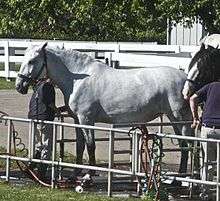Spanish-Norman horse
 Spanish-Norman horse | |
| Distinguishing features | Sporthorse |
|---|---|
| Alternative names | Spanish Norman |
| Country of origin |
Spain France |
| Breed standards | |
| Spanish-Norman Horse Registry | Breed standards |
| Equus ferus caballus | |
The Spanish-Norman horse is a warmblood horse breed that is the result of crosses between two much older breeds – the Andalusian of Spain and the Percheron of France. In 1991, a registry was created in Connecticut in the United States to maintain records of the breed. The Spanish-Norman is bred primarily as a sport horse.
History
Both the Andalusian and the Percheron have Spanish and Barb ancestry. The Andalusian horse is descended from the Iberian horses of Spain and Portugal, and derives its name from its place of origin, the Spanish region of Andalusia.[1] Throughout history, the Iberian breeds have been influenced by many different people and cultures who occupied Spain, including the Celts, the Carthaginians, the Romans, various Germanic tribes and the Moors. The Iberian horse was identified as a talented war horse as early as 450 BCE.[2] Despite their ancient history, all living Andalusians trace to a small number of horses bred by religious orders in the 18th and 19th centuries. An influx of heavy horse blood beginning in the 16th century, resulted in the dilution of many of the bloodlines; only those protected by selective breeding remained intact to become the modern Andalusian.[3]
The Percheron breed originated in France, taking its name from the former Perche province. Its exact origins are unknown, and several theories have been put forth as to the ancestors of the breed. These theories include the Percheron originating variously from Arabian stallions brought to the area by 8th century Muslim invaders, Moorish cavalry horses from the Battle of Poitiers and Boulonnais horses used by Caesars legions. It is known that much Arabian, Oriental and Spanish blood was added during the breed's history.[4]
Blood typing studies by Dr. E. Gus Cothran of the University of Kentucky have unearthed similar genetic markers in Andalusian and Percheron horses.[5]
Breed characteristics

The Spanish-Norman stands 15.3 to 17 hands (63 to 68 inches, 160 to 173 cm). Like both the Percheron and the Andalusian the predominant color is gray, although some bay and black individuals are also seen.[6] It shares the Percheron's size and density of bone; like the Andalusian, the Spanish-Norman has a refined, convex head, long neck and legs, broad chest, short back, well-muscled hindquarters and a generous mane and tail.[7] Since Spanish-Norman horses are required to possess at least 50 percent Andalusian blood, they are eligible for dual registry as half-Andalusians by the International Andalusian and Lusitano Horse Association and eligible to compete in IALHA-sponsored shows. As of 2011, over 100 Andalusian stallions are registered as foundation sires in the Spanish-Norman breed registry. Percheron mares are required to be registered with either the Percheron Association of America or the Canadian Percheron Association.[5]
Uses
With a combination of strength from the Percheron and elegance from the Andalusian, the Spanish-Norman is well suited for the show ring in driving classes and eventing.[7] Like the Andalusian, it is also used as a parade and exhibition horse.[5][8]
References
- ↑ Bennett, Conquerors, p. 159
- ↑ "Andalusian". International Museum of the Horse. Retrieved 2010-09-08.
- ↑ Valera, M., A. Molinab, J.P. Gutie´rrezc, J. Go´mezb, F. Goyached (2005). "Pedigree analysis in the Andalusian horse: population structure, genetic variability and influence of the Carthusian strain". Livestock Production Science (95): 57–66.
- ↑ Hendricks, Bonnie. International Encyclopedia of Horse Breeds. University of Oklahoma Press. pp. 335–337. ISBN 978-0-8061-3884-8.
- 1 2 3 "Breed profile". Spanish-Norman Horse Registry. Archived from the original on July 1, 2013. Retrieved July 1, 2013.
- ↑ "Breeds of the World by Continent—Spanish-Norman". International Museum of the Horse. Retrieved July 1, 2013.
- 1 2 "Spanish Norman Horse: Recreating the Spanish Norman Horse Breed". Horseman Magazine (August 23, 2008). Retrieved July 1, 2013.
- ↑ Reddick, Kate. Horses. New York: Ridge Press, 1976, p. 53 (Andalusian).
Bibliography
- Bennett, Deb (1998). Conquerors: The Roots of New World Horsemanship (1st ed.). Solvang, CA: Amigo Publications Inc. ISBN 0-9658533-0-6.
.jpg)